This is the first in a three-part series I’m writing for HRE, inspired by a problem I hear almost every HR leader speaking about: how hard it is to drive change with emerging workplace technology. Together, we’ll explore how to get approval, roll out and drive adoption—and ultimately, how to access and celebrate the success of your HR tech initiatives.
What I learned at HR Tech
I had the great pleasure of returning to the HR Tech Conference in Las Vegas this year after a pandemic-induced pause for the past two years. Attending was no small feat, as I was schlepping from Florence, Italy, directly to the conference—and it was perhaps the best conference yet, given how genuinely excited everyone was to be there, as well as the incredible openness to new introductions and hunger for fresh thinking that was on display.
As I headed back to New York City afterward, one thing kept coming to mind as I reflected on what I had learned over the week: Despite the massive innovation and investment in HR technology products, it seems harder than ever for HR to buy, deploy and fully leverage these tools.
What the heck is going on?
The double-edged sword of the explosion of promising new vendors and products is that HR tech is now squarely in the crosshairs of our friends in finance and IT. Specifically, any finance person who’s paying attention is seeing a ton of third-party expense creep—not just in centralized IT spending but also in lots of corporate-card-funded platforms used by specific teams or sites. And in IT, there exists a great desire to better control, integrate and manage these platforms, as some of them are duplicative, others haven’t been vetted for data security and many simply don’t work well with one another. All of this has led to a ton of new controls, processes and friction, making the process of buying a new HR tech product more difficult than ever before. According to Gartner, 77% of B2B buyers said their latest purchase was very complex or difficult.
Where to start?
Like many conference attendees or those joining some of the stellar webinars that HRE and other media companies produce, HR leaders certainly know their pain points: retaining talent, driving DEI progress, increasing manager capability, reigniting employee engagement in a hybrid workforce and more.
 To tackle these, however, HR must first pull up from their concerns and instead start with the organization’s broader strategy and priorities. What’s the CEO talking about with the board or investors? What does your C-suite focus on—in particular, what are the things that keep them up at night with angst or wake them up early in the morning with excitement? Start here! You’ll want to focus your HR tech efforts on areas that will drive the success of the larger organization and executive team, not just those that optimize for HR’s internal pain points or needs.
To tackle these, however, HR must first pull up from their concerns and instead start with the organization’s broader strategy and priorities. What’s the CEO talking about with the board or investors? What does your C-suite focus on—in particular, what are the things that keep them up at night with angst or wake them up early in the morning with excitement? Start here! You’ll want to focus your HR tech efforts on areas that will drive the success of the larger organization and executive team, not just those that optimize for HR’s internal pain points or needs.
Do your research
Long gone are the days when HR turns to IT to do their tech research and diligence. After all, the answer was always hard-coding SharePoint for any problem we had, wasn’t it? “Getting out of the building” physically or virtually is key when doing your primary research. Attend conferences, vendor events and webinars; scour analyst reports; peruse review sites and third-party studies; and fast-track your research by asking HR peers at similar organizations which platforms and tools they both love and loathe.
Eventually, you’ll be pitching a solution internally or making an ask, and it will be critical to bring your boss and other stakeholders along, showing them the research you’ve done to build confidence in your recommendation. The more you can prove you’ve “done your homework,” the less scrutiny your proposal will receive.
Find friends and funds internally
Seldom does anything meaningful ever move forward in an organization because of a single person. Business is truly a team sport, so you’ll need to find co-sponsors to support your ask. Seek out the executives who are perhaps next in line for succession and want to make their mark, new joiners to the org or those who may have long tenure and are thirsty to drive more change, perhaps at the end of their careers. Prioritize those who are in revenue-generating or customer-facing senior roles, as they carry greater weight and believability. Map your initiative to a priority or pain point they truly care about and one that—if addressed—would help advance their stature internally.
You’ll also need to find the budget. ROI calculators and projected cost savings and business impact are extremely helpful for making your case, but ultimately, an HR tech investment requires identifying the money you’ll tap into to pay the vendor. Having a friend in finance who can help you find where money isn’t being spent, or where savings can be found, can be a tremendous shortcut. Consider pooling budgets across departments; perhaps a co-sponsor could pay for a vendor fee, while HR or another department could provide the FTEs required to program manage the effort.
Make the ask
After you’ve made a brief deck or short memo (often, less is more here, so don’t create a 30-page deck for a $30K ask), you’ll then want to tailor it to the ultimate decision maker(s). Start not with your ask or the platform, but rather with their concerns, priorities and needs. SHRM notes that organizations are investing heavily in HR technology to improve recruitment success, reduce attrition and, in general, provide far more efficient human capital management (HCM). Next, go back into how your proposal helps them achieve their needs. Walk them through your process, the other stakeholders you’ve aligned with and your plan to implement it flawlessly. And depending on your organization’s budgets, appetite for risk or tolerance for change, consider smaller rollouts (“pilots”) as a way to get started faster, learn and prove the results before scaling further.
(Note: Avoid the trap I find that many HR folks fall into by merely “socializing” the idea and never getting vulnerable to directly ask for approval. Any good salesperson, nonprofit board member or entrepreneur knows you have to “ask for what you want”—and, in this case, you will too. A key tip is to clearly, concisely and confidently ask for exactly what you want and then shut the hell up. Really! Make the decision to tolerate your discomfort and see where the conversation goes, including thoroughly resolving key objections without getting rattled.)
Finish the swing
 Once you’ve gotten the go-ahead, now you’ll have to morph into Indiana Jones to navigate your own organization’s buying process. If you’re not familiar with this, make sure to identify colleagues who know how to “get things through” and interview them about the best people to work with in legal, procurement and IT security. Realize that historically, HR has been the lowest-priority group for any reviews, as anything customer- or review-centric has always gotten expedited. But this can no longer be the case when HR is in a war for talent. Set deadlines based on desired platform launch dates and escalate quickly if things get stalled. You’ll need to expect to have some degree of conflict with the colleagues you often see as internal clients, but don’t forget your role in this context—now you’re the client!
Once you’ve gotten the go-ahead, now you’ll have to morph into Indiana Jones to navigate your own organization’s buying process. If you’re not familiar with this, make sure to identify colleagues who know how to “get things through” and interview them about the best people to work with in legal, procurement and IT security. Realize that historically, HR has been the lowest-priority group for any reviews, as anything customer- or review-centric has always gotten expedited. But this can no longer be the case when HR is in a war for talent. Set deadlines based on desired platform launch dates and escalate quickly if things get stalled. You’ll need to expect to have some degree of conflict with the colleagues you often see as internal clients, but don’t forget your role in this context—now you’re the client!
It is at least 10 times harder to start or launch anything new than it is to maintain business as usual, so budget more bandwidth than you think you need in order to get that contract signed and vendor-approved.
What’s next?
In my next column in this series, I’ll review how the work really starts after you get that vendor agreement signed. So, once you’re at this step, make sure to celebrate along with your co-sponsors and colleagues that you’ve all gotten this far … and then get ready to start the real work of thoughtful implementation and change management.
The post How to buy HR tech: Getting started with a strategy appeared first on HR Executive.